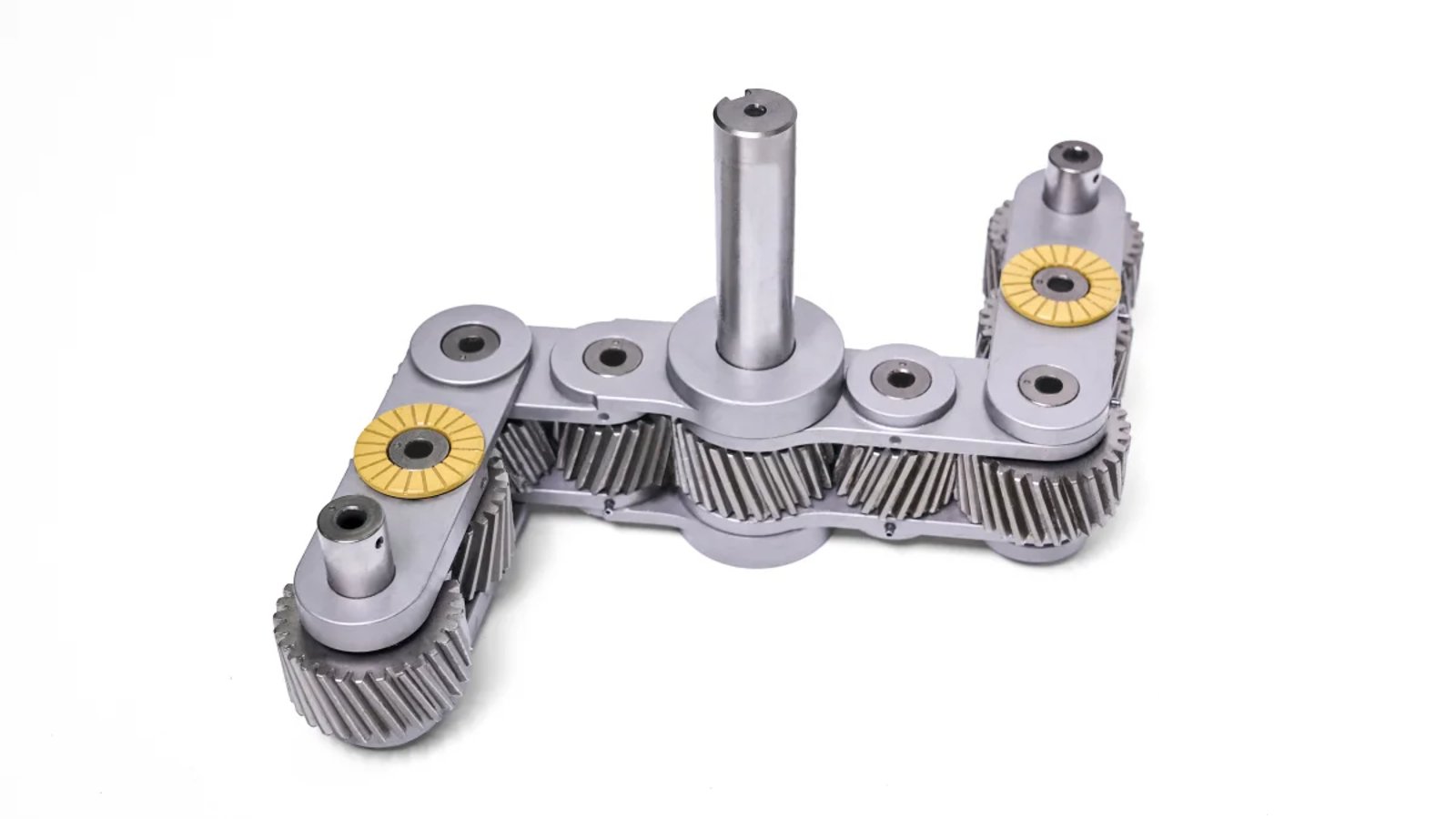Air conditioning and touchscreens didn’t alter how cars drove but did revolutionize the driving experience.
Can we please make touchscreens for neccessary functionality illegal, like using phones while driving?
Yeah, buttons can be found without looking.
They also provide tactile feedback allowing you to be sure they have been pressed without even looking.
My parents’ Lexus has a button joystick kind of thing with similar resistance tech to the ps5 triggers for the navigation. It’s not bad.
The joystick is on the center console, so you can use it without looking.
How do you see what the joystick is pointing at without looking at the screen it’s controlling.
Radio volume, climate controls, and drive/transmission controls are all necessary for safe operation and should be able to be used without taking eyes off the road if needed. There should be federal mandates to keep those controls off of gaze required touch screens. (I’m looking at you VW, of which I own 3 classic examples, but would never consider a current gen one).
I think it’s just for changing inputs and radio, not climate, definitely not volume or transmission. You do need to look at the screen though.
THE reason i got a Mazda, after many years of Mercedes and BMW…
I feel like not enough people realize how amazingly simple and tactile the rotating dial is for doing anything in a car. And especially the placement being down by your arm makes it so easy. I can feel where all those buttons are without taking my eyes off the road.
Also make them illegal in aircraft! And spacecraft! Seriously stupid.
I vote for cheap PlayStation controllers.
Weren’t they using an Xbox controller for that Titan sub?
It was a Logitech F710.
Should have used a madcatz controller, then they would have had a turbo button.
No it was a PC controller in the form factor of a PlayStation controller
I suppose the advantage on aircraft and spacecraft is that they consolidate functions so you don’t have to have 90,000 switches in the cockpit, half of which you won’t ever need.
Anything you need to find in an emergency absolutely should be a physical switch but anything else can probably be a UI interface.
But in the car you need to keep your eyes on the road at all times, which isn’t so much of a requirement in the air.
If you can consolidate the UI to make it with work with touchscreen, you can make it work with something like Keyboard + trackball mouse and you can get rid of that touchscreen. I know it’s not the same stake situation but have people forgotten how much functionality blackberry had with QWERTY and few more buttons. Shame that the company went out the way it did
I can’t think of a switch you won’t ever need. I think the “sce to aux” story is a good example of when you need it you need it.
Also make them illegal in aircraft
Salty Boeing
So much this, it makes no sense for using a portable phone to be illegal while driving but yet my car stereo can be a full on entertainment system and require me to have zero feedback to change the channel or answer a call.
Or at the very least, do what modern airplane cockpits do and have a trackpad/trackball on the center console.
I’m pretty sure they are for safety critical controls, such as in an aircraft cockpit. In the automotive world, we like to keep it jazzy and smooth, like my romantic life.
They aren’t. Light ircraft now use touchscreens that you are supposed to use while bouncing around. They had a knob for a while but then it seemed touchscreens took over. With the knob you still had to look, it at least you didn’t have to aim at a bouncing spot on the screen.
Oh wow, you guys get the cool stuff too? That must add some much need spice to the humdrum activity of controlling a potentially lethal machine.
Can we have more mechanical posts like this?
No, you need 555 posts about the shit that a billionaire said about stuff he knows nothing about
And then someone saying something about Linux
deleted by creator
On Monday I’m going to tell my boss to fuck off. He isn’t going to blackmail me into doing high quality work with money. Honestly, fuck off.
Be the change you want to see!!
A new mechanical motion is a seriously big deal and doesn’t happen often.
This requires educated users in their professions to read the news and share it to the public for free when not being paid.
There’s 2 significant inaccuracies in the article and 1 large oversight in the official video.
- Differentials are not one wheel drive. They can seem to drive only one wheel when spinning the wheels as one let’s loose and the other stays still, but it’s not driving one wheel. It’s still driving both. The problem is the free wheel is spinning at twice the speed indicated on the speedometer and the other is at 0. The driveshaft puts in a certain number of turns, the wheels, together, must add up to an equal output (multiplied by the gear ratio). If the car is going straight with full traction, then they turn the same. If you floor it in snow, one is probably spinning 40% over it’s share and the other 40% under. This is not unique to rwd either as fwd cars still very much have a functioning differential. To throw some numbers at it to help clarify the function, let’s say the engine is asking the wheels to spin at 30rpm each in a straight line. In a left turn, the right wheel travels further and needs to spin at 35rpm while the inner spins at 25rpm. It still adds up to 60rpm, same as a straight line. Mash it in the snow and it might be 60rpm in the left and 0nin the right or 0 in the left and 60 in the left. It could be 5/55, 40/20, or any other combo as long as it totals 60.
PS: differentials are irrelevant when the wheels aren’t connected to each other. Individual-motor wheels, as shown in the video, don’t need a diff. The non-drive wheels in a 2-wheel drive vehicle do not have a differential on the non-drive axle.
-
Cv joints are not specific to fwd as nearly all modern rwd cars with independent rear suspensions have CV joints. I don’t know of any trucks still using U-joints either since big trucks are solid axle. Cv joints function the same as U joints. The difference is C.V. joints output constant velocity whereas U-joints (what you’ll see often under trucks on the driveshaft, two square C shaft ends with an X link between) have lopey output that gets worse with greater deflection angle. If you own a u-joint bit for your socket wrench, I invite you to play with it. Instead of a solid pinned X between the U ends, CVs have free-rolling balls that can roll inboard and outboard to maintain the link between the shaft’s cup and the wheel’s cone.
-
The article is inaccurate but the video ignores this part, so I don’t fault The writer. The CV joints are said to be a poor design, yet, it ignores the part where the video reinstalls them at 4:20 and 5:10 for the front wheels. This mechanism does not allow angular deflection between the motor and hub, as it’s shown, without a CV joint. Lateral displacement, yes, but not angular - as in it can’t steer. This may be an overall improvement by reducing how often it needs to bend (only when steering), but it doesn’t eliminate it. And even then, the rear suspension is still designed to change camber as it changes ride height. Camber is the angle of the wheel as measured top to bottom, as in what you see from looking at the wheels from the front of the car. It keeps the wheels flat on the ground as you lean the car in a corner. You may see an overloaded car’s rear wheels look like /—\ as viewed from the rear or -–/ when hanging free on a lift.
Look, I’m not an engineer at Hyundai (or even a competitor) but this doesn’t quite pass the sniff test. Cool idea for sure, but it smells a little like marketing is clamoring for something edgy to display. Even as displayed, the motors and original reduces were already very compact and in close proximity to the wheels compared to a normal engine. The slightly reduced footprint of this uni wheel and slightly increased friction of a bunch of additional gears makes me think this is a fractional improvement in practice rather than a revolutionary improvement.
I’d be concerned with the amount of unsprung weight this adds, too. You’re basically taking the transmission and adding that mass to the hub. Seems like it would be pretty crashy on rough surfaces.
I considered that but couldn’t make any conclusions. The driveshaft and sun gear are not added to the unsprung. I’d guess only half the weight of planets and carriers is added. It definitely adds the weight of the ring gear to the unsprung mass.
I’m also curious how this affects rotational mass. So while every component spinning with the wheel from tire to motor shaft has rotational inertia, small-diameter components such as drive shafts have relatively little rotational inertia. Wheels and even brake discs have a lot more. I don’t have numbers obviously but I’m curious if the rotational mass of the ring gear ends up being detrimental compared to a heavier-weight lower-inertia cv setup.
Isn’t the ring gear the wheel body (or whatever it’s called), that is, even a fixed axle would have weight there, the gearteeth even provide stiffness. CV joints also contain unsprung mass, I’d say there might be a bit of a difference but nothing drastic. With modern fancy biomimetic wheel body geometries and everything you’ll probably definitely be lighter than 80s steel rims. What happened to spoked wheels, anyway.
The CV only contributes half it’s mass to unsprung weight, and this system still requires a drive shaft and either a CV or u-joint. But with more mass at the hub.
Typical hubs are still lighter than this, because this setup still requires the hub structure, it’s just adding gearing out there.
Half of the hub is unsprung, the transition between sprung and unsprung is at those fancy articulating planetary gears. The drive shaft is definitely sprung, it and the motor is completely static relative to the battery and everything.
Yep.
Trucks used these as far back as pre-WWII. It a great solution for off road vehicles to gain clearance. At low speeds, even universal joints work fine for this setup, because the shaft rotates at 1/3 wheel speed, like a drives haft does going into a differential.
This puts a diff at each wheel.
Edit: These are called Portal Gears
Not quite portal gears, that has the input shaft fixed at the top. This is like an adjustable portal gear.
Meh, it’s still a portal hub, where you put the input shaft is a minor difference. It’s still putting the gearset in the hub, increasing the total weight of the vehicle, and increasing unsprung weight.
Calling it a new thing is a lie. All they’ve done is switch it to planetary gears. I’d bet lots of money this was tried a long time ago, and was shelved in favor of an offset input shaft.
I noticed they conveniently didn’t talk a lot about steering…
The claim of “one wheel drive” I think is meant to highlight what happens if traction is lost. It sounds like something I have heard on 4wd off-road forums. I agree the phrase “one wheel drive” is perhaps not a great way to explain the disadvantages of differentials vs limited slip differentials vs locking differentials vs individually driven wheels.
The idea of “one wheel drive” as I have seen it used, is that in a vehicle with one powered axle assembly (what we normally call 2wd-- either front or rear wheel drive) is that if you lose traction with either drive wheel, the vehicle no longer moves because all power is diverted to the slipping wheel.
If you have a limited slip differential, there is a limit to how much power is diverted to the slipping wheel. With a locking differential, you only stop moving if you lose traction to both drive wheels.
Anyway…
The design is really interesting.
You also bring up a good point about how camber changes with suspension position. Also the effective track width changes, such as with my 4Runner which has upper and lower control arms, a Double wishbone suspension. If the motor remains in a fixed position, the wheel will move onboard and outboard relative to the motor depending on suspension location.
I don’t quite get how these two effects are addressed with this new design. Or are the suggesting a different suspension technology that they didn’t discuss?
As for steering, I wonder if the design rotates the motor along with the wheel. In that case no CV is needed but I would guess there are some downsides to such a design.
I agree the video seems kind of… premature. The mechanism is cool but I don’t get the sense that its applications haven’t exactly been nailed down yet.
Individual motors on each wheel will still slip, just with half the power. So sure, it’s an improvement by an unrelated mechanism, but not having the wheels connected with a limited slip means it’ll still need a traction control system. And even still, the “half” power is a relative term because every car has a different output. That goes for not connecting left to right as much as it goes for front to back. So, not different than a traditional open diff or 2wd. There have been advances in brake-based traction control so they don’t just cut power and apply single brakes like the 00s, they can properly modulate pressure to get equal propulsion.
That’s a good point you’ve mentioned as well - the wheel will change distance to the motor as it goes through it’s motions. The only way to avoid that is to place the motor at the effective pivot point of the suspension which is, in a properly design suspension, inside the other wheel to mimic the level dynamics of a solid axle. That of course defeats the short halfshaft design direction. So something has to allow variation in distance. In the non-steer wheels, maybe this could be as simple as a telescoping spline drive. However, the video shows a small black joint at the same time stamps above on the rear and still has those normal-looking cv boots on the fronts.
Or maybe they’re ditching good handling and going with perfectly vertical suspension travel. Give it hard eco tires and it’ll slide before the suspension shows it’s flaws.
deleted by creator
The steering wheels’ hubs rotate in two directions. The steering action rotates through a vertical axis while the typical suspension rotates in a front-to-back axis pinned approximately through the other side of the car. So unless they abandoned common suspension design to let tires lean in turns more than a reasonable amount, there needs to be an allowance for angular deflection. A pinion gear arrangement sounds like it would take up a lot of the space they’re trying to save but still not solve the multi-axis problem found at all 4 wheels. I’m trying to not take their video so literally but it’s not like it’s a dealership rep spouting incomplete info here
Unrelated comment, but holy shit I am a huge fan of the M8. So wild to see you on Lemmy, and this comment section is exactly what I’m here for.
deleted by creator
But you need a CV or Universal on that drive shaft to accommodate suspension travel (or steering if needed on that wheel).
deleted by creator
Now imagine there is a handle sticking out of the crankshaft that needs to rotate around the shaft with the hand crank as it gets turned. That is the motor.
The video never showed the motor moving along with wheels turning, only the up and down part. In fact, when they showed space savings they showed the motors as stationary with no clear way to turn.
deleted by creator
Suspension movement still requires flex in the shaft. There’s no way around it unless the engine moves with the suspension
deleted by creator
deleted by creator
With how small the motor is you could also pivot it alongside with the wheel, after all, something pivoting with the wheel doesn’t mean that it has to be unsprung.
- You are sort of correct about this, but it’s irrelevant since everyone moved onto limited slips decades ago.
As to the rest- you’re wrong. Sorry.
But the real reason this tech won’t be very important is because it’s a lot more complicated and expensive than a cheap ass cv joint and is minimally more efficient. I can buy both sides of my vehicle for like $80 and don’t have to worry about em again for ages. I think this new hyundai stuff could be reliable, but it’s going to be a lot more expensive.
Also, they look like they’d be noisy.
you’re wrong. Sorry.
No u. Bam, same level argument right there. Are you going to explain why or just throw out contrarian comments?
Cost will not be a limiting factor. Just about every feature on a 2023 car already costs more than a 1993 car’s version. Did adding a wheelspeed sensor, electronic 4-channel hydraulic brake actuator, and dedicated ecm programming cost too much to implement ABS? Did the complication of 40 sensors (100+ now) and a voodoo box of electronics cost too much to go efi instead of carbs? Did the price of disc brakes stop most cars from ditching rear drums? Did the cost of engineering and testing prevent manufacturers from implementing the following nearly-negligible aero improvements to eek out another 0.1% of fuel efficiency;
-
aero strakes into mirror shells (prius, escape)
-
relaminating roof spoilers into every hatchback/suv and even into every pickup bed
-
Vortex generators on the top surface of tail lights (sonata, chr)
-
Active grille shutters (fusion)
-
Full underbody trays
-
Chin spoilers (splitters) on just about every car to keep air out from underneath
-
Hood beak splitters to keep grille air off the canopy (Volvo, accord)
-
Short antennas/glass-embedded antennas to reduce antenna drag
-
Front fender outlet vents to create laminar flow over the wheels (f150 2015+)
No, it didn’t.
And I’d be interested to hear why you think helical-cut gears will be “noisy”. I’m guessing you don’t know why reverse whines in certain cars but not the forward gears
Edit: also, seriously, go do some shopping. LSDs are on the decline. On top of never being common in the first place, manufacturers at removing to brake-based simulated LSD rather than discrete components. There are incredibly few Fwd cars that ever had LSDs and fwd obviously makes up the majority of North American sales. Even Miatas and Mustangs only get LSD with optional packages.
Yeah the amount of BS or confidently incorrect in tech articles about automotive engineering is crazy.
And while gear-sets are really efficient, adding 8 to each of the 4 wheels 32 total, in leu of 2-4 at each end of the car, plus 4 CVs (assuming it’s AWD) has to be close in efficiency. And as a DIY+ car restorer in New England. I wanna see how they seal this thing. And with steering wheels it’s either gonna have to swing the motor around or put the CV back in anyway.
NVH (noise vibration harshness) is also going to be a huge factor. That and cost and weight is why we don’t have gear driven camshafts except on a select few exotic motorcycle engines and F1 engines.
Helical gears are the cost effective way to reduce gear noise, but they impart axial loads which would be difficult to overcome in this hinged joint. Herringbone fears eliminate the axial load, but are much harder to make, unless you go with powdered metal sintering. Which I barely trust in a cordless drill, let alone a Kia.
Edit: And no accounting for wheel castor, or camber changes along the suspension travel (way more basic and important for handling than torque vectoring). This video is pure marketing wank.
Funny you mention motorcycles with gear-driven cams as being exotic. Generally correct, but I happen to own one of the cheapest out there: the Honda VFR. I sought out mine for being the last with the gears before going to a normal drive in 02. It’s a glorious sound.
Anyway, that’s true too, helical gear will need a beefy housing to resist that axial load. That’s more weight. A pair of helicals fastened together could help bring down cost, probably, compared to herringbone, but that’s added complexity. I can’t claim the tech is marketing wank but the video absolutely is
-
Irrelevant since everyone moved onto limited slips decades ago.
Lol, what?
My RSX was made two decades ago in '03, so the newest that would be multiple decades old. It’s also a Type-S, the sporty model. It’s got an open diff.
My '93 Subaru Loyale, which is 3 decades old, has two open diffs, with a locking center diff. No limited slip.
My '04 (almost decades old) Crown Vic PI doesn’t have an limited slip. It was an option on Interceptor that the city didn’t opt for.
My '07 (not decades old) Volvo XC70 has no limited slip diffs. It uses the traction control to try to imitate them, but no actual limited slip differentials.
My partner’s '07 (still not decades old) Kia Spectra5 has an open diff.
The only car in my fleet that has a limited slip is my '02 Subaru Legacy Outback, and it was an option that the person who bought it new opted for, and it’s just the rear that’s limited slip, the front is still an open diff. Apparently the limited slip isn’t even that good either, you can still get stuck with two wheels spinning. I haven’t tested that yet, I just got the car.
If you go out and buy most cars today they’ll come with open differentials. The traction control system will likely try to compensate for this, but they do not have limited slip differentials.
Yea, companies love to tout their “electronic differential” that’s nothing more than an open diff and traction control via the brakes (Toyota Tundra comes to mind, as recent as 2017).
Yeah. I guess the person I replied to fell for their marketing? However, even traction control wasn’t terribly common 20 years ago. I’m not sure what they’re on about.
It surprises the hell out of me that ABS wasn’t even mandatory in the US until 2008 I think. Retro mustangs were available without it. I think we got mandatory tire pressure monitoring around the same time, actually, although it was done by comparing wheel speeds over time. So yeah, traction control wasn’t all that common indeed. I think GM was still running 3-channel ABS on their trucks then too
Me too, it was super late. However, holy crap it’s different in quality between manufacturers.
My RSX has great ABS, even on gravel or in the snow. It does way better than I could in most situations. Coming from my '98 corolla (without ABS) to the RSX was a massive improvement in braking.
The ABS on my Crown Vic, which is one year newer than my RSX, just doesn’t work. You don’t lock up the wheels, so I guess by the definition of ABS, it works. However, the ABS also increases your stopping distance by a lot. I need to figure out the best way to disable it. Pulling a fuse doesn’t work, as that’s also the fuse for the dash instruments. When I do it I’ll do a test to make sure that the stopping distance is improved by as much as I think it will be.
That’s interesting, so it is pulsing under heavy braking? Is that a common problem? I wonder if either unplugging all the sensors or maybe the module itself would disable it. Just the sensors might freak it out and cause constant abs actuation each startup until it confirms the fault.
Just how many cars do you have, exactly??
- It’s a hobby. I justify it because they’re worth under 15k combined. Many folk have two cars worth double of all 6 of mine combined (licensing/insurance included)
The RSX is on the chopping block. I want to get a more dedicated sports car, since I’m privelaged enough to own multiple vehicles.
The Outback and Volvo are wrecked title purchases from copart that I’ll get salvage titles for, then enjoy for a bit before selling to break even, or even for a possible profit.
The crown vic is my beater. I drift it. I take it on logging roads. I take it on the Gambler 500. It’s fucking awesome. I’ll always have one, probably.
The Loyale is something I’ve wanted since highschool. I love the push button 4WD. I love how comically slow it is. I love the interior. I get quite a few compliments on it. It needs some work, but that’s part of the fun. I dunno if I’ll own it forever, but I really like the thing.
I, as of recently, own my grandpa’s 1984 Oldsmobile Delta 88 Royale. I’ve gotten similar compliments to the Loyale on it. My grandpa is about two weeks away from dying of cancer. I’ll own that car forever.
My partner owned a Spectra5 when I met her. It’s our economy car, which every household needs. I’d like to upgrade it to a Volt at some point.
I definitely own too many vehicles, but I love the variety and unique characteristics of each of them.
Sort of related, but I’m not one of those dickish gearheads, I use and support public transport, and think that the world as a whole would be better off with fewer cars. If one doesn’t want to drive, then they shouldn’t fucking have to.
Hey don’t let me take your fun away from you. I just think it’s an unusual amount of cars, but if you enjoy it then that’s great! Sounds pretty cool tbh
Now thar Hyundai has patented it, it will never become popular enough to impact the market and be standardized in more vehicles or change anything, similar to the Wankel engine.
similar to the Wankel engine
Was the Wankel engine really a step forward though? I’m a gearhead who does all his own car maintenance, up to and including engine swaps in the past and retro-modding bigger turbos and aftermarket fuel injection systems into my cars (Datsuns in the latter case). That being said, I only know the very basics about rotary engines. I’ve always admired the Mazda RX’s from afar.
Mazda, who by no means makes a bad gasoline engine, could never get a rotary motor to last well or to have anywhere near decent fuel economy. Also, the rotary design was tried for a while in at least refrigeration compressor applications, where it blew up there a lot more than the other types of compressors as well.
Yea. They have worse efficiency. To get better efficiency from them you would need to run them hotter (afaik), and if you do that they would last even shorter.
It’s great if you want a smaller but still strong engine, but it’s not efficient and those seals are a big problem.
The problem with the rotaries is a result of the technology of the time and funding.
They are inefficient because they lose compressed fuel and air as the seals pass over the holes for the spark plugs, which can be largely solved with laser ignition. They are less reliable because of the design of the apex seals, which can be solved by using a roller instead of a blade. Both of those major issues with the rotary could not be solved with the technology of the 60s-00s and the tiny budget available. There are other issues that hold back the design, but those come down to metallurgy and manufacturing processes. Mazda did a great job trying to make the rotary work and it almost killed them.
The other issue that gives then an unreliable reputation is because you can’t treat them like a piston engine and people treat them like a piston engine. Hard to fault the knife for breaking when it was used as a pry bar.
which can be largely solved with laser ignition
hoo lee I’ve never even thought about that, that sounds sick as hell
The argument is, though I’m not qualified to assess it, that Wankel engines are simpler, smaller, more power dense and, if allowed time to develop, would be an improvement on the traditional ICE. It’s very difficult to assess where we would have ended up and a little by the by, given we need to move away from burning fossil fuel.
That said, do check out LiquidPiston’s evolution of the Wankel engine. It does sort of look like they’ve solved a number of issues a traditional Wankel engine has.
if allowed time to develop
The basic problem with Wankels is that the geometry of the combustion chamber (such as it is) is constantly changing, which inevitably results in incomplete combustion compared to traditional ICEs. This leads to lowered fuel efficiency and greater emissions; the emissions problem is solved with an additional combustion chamber for the exhaust gases, but this consumes more fuel and lowers efficiency even more. It’s just a fundamental problem with the technology that no amount of development could ever fix.
It still has corners that need to have a moving seal. This is a huge issue.
But capitalism creates innovation!!!
Some people argue that intellectual property law is not free market capitalism, and is instead a regulation that benefits big business. I’m one of those people
While I’d agree in essence, in practice I don’t. They’re an offshoot of capitalism. The goal of capitalism is profit, and if you can create barriers to competition, that protects your profit. IP law is something created out of capitalism as a barrier. If it isn’t the government doing it, it’d be goons hired by those in power. They exist because of capitalism, not from something external to it. If the system were focused on doing good or creating utility, IP law wouldn’t be required.
Free market and capitalism are mutually exclusive as in the theoretical model that is the free market, with perfectly rational actors and information, a capitalist class cannot exist, they’d quickly get competed down to size.
Unregulated markets and capitalism, now that’s a lovechild, as without regulation real-world markets quickly turn into monopolistic shark-tanks instead of free markets, actors not being rational, information not being perfect and all. The role of regulation, indeed the state, is to correct for that factor and make the real-world market approximate the free market.
(This view of the world brought to you by ordoliberalism, the only sane liberal economic theory there ever was or probably will be – because they actually managed to side with the free market, and not capitalism, as the rest of them).
And regulations restrict both.
Cars should be able to pollute as much as the manufacturers want because innovation is all!
“Probably failed cuz they called it the wanker engine lmao. Now set aside another few milli for the copyright lawyers”
Indeed, nothing that is patented ever makes it to market…
Did none of you watch the video? The article is crap, but the video explains it well.
Go back and watch the video, ya old codgers!
deleted by creator
Here is an alternative Piped link(s):
https://piped.video/Nd6C0y8xc20
Piped is a privacy-respecting open-source alternative frontend to YouTube.
I’m open-source; check me out at GitHub.
I watched the video, but burying a good video under a trash article does not a good sauce make. OP should have just linked the fucking video.
deleted by creator
What a badly written article, wrongly explaining both the diff and the CV joint. That’s not what they do or how they work.
Yeah, skimmed and saw one of his other articles praising the cybertruck and realized this likely wasn’t a source worth absorbing.
One thing I took from the article is they’re trying to sale the idea of having MORE space in a car due to smaller transmission system. In 1 presentation, they show the idea of putting a FUCKING DOUBLE BED IN THE CAR!
I DON’T want MORE space in the SAME sized cars.
I want the SAME space but in SMALLER sized cars.
The space we have now is FINE, and the car sizes are TOO BIG.
STOP MAKING BIGGER CARS!
If we could get standardized and interoperable electric car parts, that’d be great.
Imagine that XKCD competing standards comic here
trying to sell* the idea
You’re complaining like this doesn’t also mean the same space in smaller cars. Improvement is improvement.
They have taken us for fools
Seems really cool. I will definitely not buy the first model vehicle to use this, though.
Surprisingly easy to understand video for a complex concept.
Here is an alternative Piped link(s):
https://piped.video/Nd6C0y8xc20
Piped is a privacy-respecting open-source alternative frontend to YouTube.
I’m open-source; check me out at GitHub.
It is made by Hyundai, I wouldn’t touch anything close to cutting edge they make.
I can already see this tech holding a yard sale on the freeway after a pothole.
After owning a Hyundai I won’t touch anything made by Ford or Chevy again. This car has had literally nothing wrong with it for over 70k miles. Except routine maintenance like brakes, oil changes, air filter and tires.
I worked in automotive for years. Hyundai/Kia fail spectacularly in ways no modern car should. Randomly catching fire to the point you are advised to not park inside, engines destroying themselves due to a manufacturing/design error they lied about, a faulty design in the transmission control unit that causes forward and reverse to invert should there be a short in the tail light, thousands of dollars in damage or engine loss due to a failure of a $0.50 motor that is not weatherproofed, among other things.
After the Theta II engines starting blowing up they came out with their 100k mile warranty. That is not a sign of confidence in their product, that is a confidence-man tactic.
The explaination of how differentials work was painfully wrong. An I lost confidence in this author’s ability to explain the topic.
Ok. Care to elaborate, please?
Apparently I can watch that video every couple months and still be equally amazed by it.
Please remind me to watch this again in a few months, it’s super cool.Right?
I’m continually blown away at what 19th-century engineers understood and could do.
Perfect
Here is an alternative Piped link(s):
https://piped.video/yYAw79386WI
Piped is a privacy-respecting open-source alternative frontend to YouTube.
I’m open-source; check me out at GitHub.
Perfecter
I knew exactly which video that would be. Such a perfectly clear explanation.
That was awesome and perfectly explanatory. I learned something new today
There’s a bunch of old training vids like that on YouTube. Lots of people could learn how to present from them - they’re so much better than most stuff on YouTube.
There are a lot of these from back in the couple of decades after WWII when society actually cared about science and knowledge and companies used the spreading of knowledge as a selling point.
https://upload.wikimedia.org/wikipedia/commons/3/3e/Around_the_Corner_(1937)_24fps_selection.webm
Wiki to the rescue!
It’s a great video from 1937.How the automobile differential allows a vehicle to turn a corner while keeping the wheels from skidding. Reverse telecine & introduction edited out.
And the article has info as well https://en.m.wikipedia.org/wiki/Differential_(mechanical_device)
Modern cars have “traction control”, which detects when a wheel turns more than the other wheel. If it turns too much more, it will engage a “diff lock” and lock the differential which makes each wheel turn with the same power/speed/energy as if the differential was just a solid axle.
The long & the short of it is that a differential is only “1 wheel drive” when the differential “thinks” (it’s not smart) it should put all the power into 1 wheel - which is when the cars computer locks the differential.
That’s only some cars.
Many today still use open diffs. Some use open diffs and braking to produce a result that looks like traction control or a torque biasing diff.
Some cars use electronically-controlled diffs that can vary pressure on clutches using simple electric servos to bias torque - Bendix is a big supplier of such things to companies like Honda.
Others use hydraulics, similar to torque converters, to bias torque (e.g. Audi’s original Quattro system).
And others use gearing to bias torque, such as Quaife differentials.
Factory systems (with rare exceptions) don’t use locking diffs (GM has one as an option, others may).
Please forgive my laziness - https://chat.openai.com/share/45e326f5-1653-4c51-b057-b36326963559
Came here to say this.
It was sooooo wrong. Painful is right.
The one thing they don’t really talk about is how it turns. The animations show vertical movement almost exclusively. At one point in the video there is a far shot showing a car turning and it looks like they actually swivel the entire motor to keep it perpendicular to the wheel which if true is going to pretty heavily limit it’s turning angle and radius.
The front wheels show CV-looking boots at 4:20 and 5:10. Even the rear wheels will likely need cv joints. Independent suspensions change camber with that coroner’s ride height to improve traction. That’s why when a car is overloaded, the wheels look like /—\ and when it’s on a lift, the wheels go -–/ (to varying degrees).
While there is some kind of boot shown the entire selling point of this thing was that it’s supposed to eliminate the need for CV joints. At that same 5:10 mark or there about you can also see the shot that appears to show the motors being pivoted to turn the wheel. I suspect these are not CV joints although they are joints most likely for camber adjustment as you point out, probably something like a universal joint.
A U-joint has worse modulation between input and output than a CV joint. However, I did look again at the video as big as I could and you are right, the motors are pivoting. It seems to only pivot a partial amount and still at an angle to the wheel. Something is still being glossed over.
Not a problem in RWD applications.
The whole pitch was based on replacing CV joints on front wheel drive vehicles.
From the presentation it looks limiting and to be honest it looks a bit overly complicated and likely to have some massive early growing pains. CV joints are comparatively simple and this is supposed to be more reliable? That’s not how it works.
There’s still CV-joints there in the video despite the uniwheel. You can’t turn the wheels without one. I’m probably just not understanding this but seems like instead of making the drivetrain more simple this just adds more moving parts that’s going to need oil changes and replacing.
Always need a flexible joint such as CV or Universals to compensate for suspension movement. And they work in pairs, because +angular change is compensated by - angular change of opposite end of shaft.
My guess is they will only put this on rear-wheel-drive cars. The system doesn’t look like it can rotate at all on that horizontal plane and moving the entire motor (that is sticking out of the back of the wheel) is basically a non-starter.
Edit, it may be possible to add another gear-set to enable rotation on the horizontal plane. But at that point I’m starting to wonder if the entire system is getting too complicated.
Like a CV joint? They kinda made a point in how great it was to get rid of the CV joint only to need to put it back in to get steering.
Even if it was only useful at the rear, it would allow the battery to be moved further back and produce a better weight distribution. Most cars are front-heavy.
deleted by creator
Ok but then torque changes when you turn the wheel. Hopefully the effects are too slight to matter
deleted by creator
I think they’re getting at the fact this design would generate massive amounts of torque steer. With the motor input vertical, any rotation will also try and change your steering direction.
deleted by creator
For the lazy people out there: https://www.youtube.com/watch?v=Nd6C0y8xc20
Here is an alternative Piped link(s):
https://www.piped.video/watch?v=Nd6C0y8xc20
Piped is a privacy-respecting open-source alternative frontend to YouTube.
I’m open-source; check me out at GitHub.
If you’re gonna go through all this trouble, why not put motors directly into the wheels? Then you can bypass the drivetrain all together and directly power the wheels.
If you put the motor in the wheel you increase the unsuspended mass. Bad for handling and ride quality
deleted by creator
4 motors is more expensive than 1 motor and a bunch of gears
Do really need need 4?
If you cant get by on 2, you might have less power, but you can get better efficiency. With better efficiency you can have a smaller battery for the same range and reduce some of your increased cost that way.
And also, if one of the wheel motors breaks down will the inevitably obtuse software of the car allow me to drive on three wheels, or will it sit idle until a certified technician arrives and inputs a service code?
We both know the answer to that question. And boy howdy am I stoked for cars to get fully enshittified where you have to have a yearly subscription for the software that allows your tires to move, otherwise you functionally just bought a 45,000 dollar paperweight.
Not a new idea, military trucks used reduction gear drives in the wheels before WWII. Edit: Portal Gears.
One downside to doing this is adding unsprung weight, which is not a good idea.
And it will still need a CV at the wheel to accommodate suspension travel.
You’re right on unsprung weight, this is going to add quite a bit, especially if you fill the thing with oil.
Not sure how you still need a CV though, as this performs that function. Watch the video, there’s a good animation. Basically this is a reduction gear and CV joint in one unit.
Camber. It allows the wheels to tilt allowing them to keep their entire tread on the ground when only one side of the vehicles suspension is compressed, like during a turn.
Ah Good point, I had not considered camber. As it stands this looks like it would probably not be compatible with much camber flex if any.
Also need them to steer the car
I don’t understand how they are going to keep dust and dirt out of it. The point where the drive input goes in has so much movement.
It will have a boot or case on it and will be filled with grease. Just like a cv joint or ball joint.
Then how is it an improvement?
deleted by creator
So in short, this adds suspension directly to the wheel, at the cost of higher maintenance? That’s it?
While increasing energy efficiency and available space, both of which can be used for extending EV range (by adding more batteries that deplete more slowly) - one of the biggest EV issues right now.
Or you could just fit a mini party bus inside a hatchback, whichever you prefer.
To your point though, one of the othe big EV issues is cost (both purchase and maintenance) - even if a large chunk of it is artificial. Wonder what the price tag and lifespan on these things will be.
EV maintenance cost is quite low compared to ICE vehicles. Brakes and suspension are probably the biggest wear items, but brakes have comparatively less wear because of the regen braking.
Nope - the ~~ADAC ~~ (turns out, i was wrong about that) GDV in Germany did a study a few weeks ago and they found EV maintenance is actually higher, because parts are so much more expensive and also brakes are needed a lot more regularly. However, the last one could be just a german problem, because of our TÜV. Edit: https://www.gdv.de/gdv/medien/medieninformationen/studie-e-autos-sind-bei-der-reparatur-ein-drittel-teurer-als-vergleichbare-verbrenner-155216
The article talks about the cost of “repairs”, not “maintenance”. Those are two different things.
Yeah you have to look at lifetime cost
How are brakes needed more regularly? Most of the braking a normal driver would do is done by the motor(s). Sure, the vehicle is heavier than a similar sized ICE counterpart, but I would guess a typical driver is using one-pedal driving whenever possible. Anecdotally, I have an Ioniq 5 and brake almost exclusively with regen, whether it’s I-pedal, or shifting between the four levels of regen when decelerating from higher speeds.
Because they rust when you not use them and always use regen. And most BEV drivers do not “maintain” their brakes, as they do not brake more vigorously to free the rotors of rust. There’s a limit as to how much wear/grooves your disc can have and at least for many Teslas that’s one of the reasons why they fail their first TÜV check up after 3 years. (Not to mention the horrible quality of Tesla suspension and chassis components…)
Volt owner checking in. I do one pedal driving 95% of the time and you’re right. My brake disks are in rough shape because they see so little use.
You can’t always use regen as it doesn’t stop the car quickly enough in many cases. From my own experience, regen probably gets used about half the time when braking.
Could you link the study? The article I saw last week was just about the quantity of unplanned issues, with the overall cost being much lower for EVs. If you could link it we can compare and see if we’re taking about the same thing.
That study says nothing about maintenance but is about repair cost after accidents. Those are 1/3 higher for EV because also small damages to batteries can increase risk of fire and batteries are also more readily exchanged due to lack of experience of the shops.
Everyone is talking about breaks while the study doesn’t say anything about that.
It’s not suspension. It compacts down the differential and cv joint (linkage from the engine to the wheel).
It compacts the whole drivetrain, from engine to the wheel. The space saving they were showing was mostly from the miniaturization and splitting of the motor.
It’s pretty smart. It is like a wheel-motor but without all the unsprung weight.

























